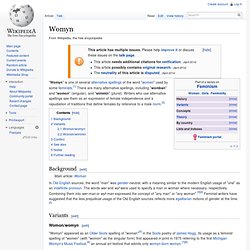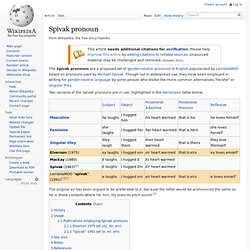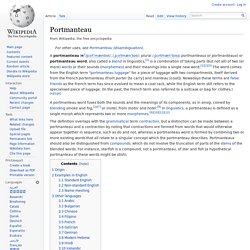

Womyn. Background[edit] In Old English sources, the word "man" was gender-neutral, with a meaning similar to the modern English usage of "one" as an indefinite pronoun.

The words wer and wyf were used to specify a man or woman where necessary, respectively. Combining them into wer-man or wyf-man expressed the concept of "any man" or "any woman".[3][4] Feminist writers have suggested that the less prejudicial usage of the Old English sources reflects more egalitarian notions of gender at the time. [2] Variants[edit] Womon/womyn[edit] "Womyn" appeared as an Older Scots spelling of "woman"[5] in the Scots poetry of James Hogg. Womon/wimmin[edit] "Wimmin" appeared in 19th century renderings of Black American English, without any feminist significance.
Conflict[edit] "Womyn" is considered a generalizing term and is highly debated by marginalized feminist groups.[10] See also[edit] Notes[edit] Jump up ^ D. Further reading[edit] Sol Steinmetz. Spivak pronoun. The Spivak pronouns are a proposed set of gender-neutral pronouns in English popularized by LambdaMOO based on pronouns used by Michael Spivak.

Though not in widespread use, they have been employed in writing for gender-neutral language by some people who dislike the more common alternatives "he/she" or singular they. Two variants of the Spivak pronouns are in use, highlighted in the declension table below. The original ey has been argued to be preferable to e, because the latter would be pronounced the same as he in those contexts where he, him, his loses its aitch sound.[3] History[edit] In 1975, Christine M. The May 1980 issue of American Psychologist reported on a study by Donald G. In 1983, a mathematician-educator, Michael Spivak, wrote an AMS-TeX manual, The Joy of TeX (1983), using E, Em, and Eir. Usage[edit] Nomic games, especially on the Internet, often use Spivak pronouns in their rulesets, as a way to refer to indefinite players.[11]
Buffalo. The sentence's meaning becomes clearer when it's understood that it uses three meanings of the word buffalo: the city of Buffalo, New York, the somewhat uncommon verb "to buffalo" (meaning "to bully or intimidate"), as well as the animal buffalo.

When the punctuation and grammar are expanded, the sentence could read as follows: "Buffalo buffalo that Buffalo buffalo buffalo, buffalo Buffalo buffalo. " The meaning becomes even clearer when synonyms are used: "Buffalo bison that other Buffalo bison bully, themselves bully Buffalo bison. " Sentence construction Bison engaged in a contest of dominance. This sentence supposes they have a history of such bullying with other buffalo, and they are from upstate New York. A comic explaining the concept The sentence is unpunctuated and uses three different readings of the word "buffalo". Marking each "buffalo" with its use as shown above gives: Buffaloa buffalon Buffaloa buffalon buffalov buffalov Buffaloa buffalon.
Usage Other words using the same pattern. Portmanteau. A portmanteau ( A portmanteau word fuses both the sounds and the meanings of its components, as in smog, coined by blending smoke and fog,[2][7] or motel, from motor and hotel.[8] In linguistics, a portmanteau is defined as a single morph which represents two or more morphemes.[9][10][11][12] Origin[edit] The word "portmanteau" was first used in this context by Lewis Carroll in the book Through the Looking-Glass (1871),[13] in which Humpty Dumpty explains to Alice the coinage of the unusual words in Jabberwocky,[14] where "slithy" means "lithe and slimy" and "mimsy" is "flimsy and miserable.

" Humpty Dumpty explains the practice of combining words in various ways by telling Alice: You see it's like a portmanteau—there are two meanings packed up into one word. In his introduction to The Hunting of the Snark, Carroll uses "portmanteau" when discussing lexical selection: Humpty Dumpty's theory, of two meanings packed into one word like a portmanteau, seems to me the right explanation for all.